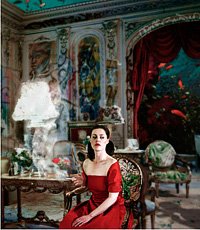PRESS RELEASE – LOOP Video Art Fair 2006
Claire Oliver presents: Jezebel
A multi-media installation by Carla Gannis

Carla
Gannis’ 5 screen video installation Jezebel is part cultural
anthropology and part dream-scape surrealism. Her "Jezebels" are set
within fragmentary layered interiors, where past and present worlds
collide. Ornate rooms, church sanctuaries and institutional green
hospitals are "wallpapered" with urban graffiti and detritus. Jezebel
is a woman caught between realities, existing in the future, present
and past simultaneously.
Approaching the
work as a three dimensional moving painting, Gannis’ Jezebel intimates
the mythology, history, and stereotypes that shape and define
femininity within our collective unconscious. This icon is not one
woman, but many, ranging from a villain to a non-conformist to a
superwoman of human empowerment. The color red as a signifier of lust,
sexuality, wantonness, as well as revolution, anger, and courage; we
see this color wrapping not only the figure but her words.
Gannis,
a native of the Southern United States, was first inspired by the 1938
film in which an outspoken 19th century Southern belle -- played by the
actress Bette Davis -- is ostracized and labeled a "Jezebel" for
wearing a red dress, instead of a "virginal" white dress, to a formal
ball. From this character, one Gannis could personally and regionally
identify with; the artist researched the more universal interpretations
and contradictions that surround the avatar Jezebel.
In
a reference to cinema and painting, Gannis provides five mise en scènes
that give context to Jezebel’s historic and cultural currency. She has
collected numerous texts and woven them together into visual and
textual personifications. Her five representations include:
Jezebel
PIAF: based on singer Edith Piaf’s loving tribute to Jezebel and
includes texts that address darkness and religious antithesis
Jezebel THE PREACHER : based on the age-old representation of Jezebel
as a pagan temptress (contemporary religious leaders still refer to
"Jezebel" as an entity that is threatening in these texts)
Jezebel THE RAP: where misogynistic lyrics and a sexualized Jezebel are
inverted, and where language in regards to female sublimation explains
much of Jezebel’s villainy
Jezebel BETTE: where monologue is taken from the original "coquettish" Bette Davis performance
Jezebel CHRISTINA: the woman who actually plays Jezebel in this work,
as herself, a real woman, who contends with racial and personal
identity politics -- politics not dissimilar to those encountered by
black female slaves as well as white females activists derogatorily
called "Jezebels" during the first 200 years of US history.